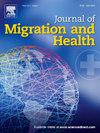Determinants of institutional delivery service utilization among internally displaced vulnerable populations in Benadir region, Somalia: A community based cross-sectional study
IF 2.9
Q1 PUBLIC, ENVIRONMENTAL & OCCUPATIONAL HEALTH
引用次数: 0
Abstract
Background
Every day, nearly 830 women succumb to preventable pregnancy and childbirth-related complications, with 99 % of maternal deaths occurring in developing nations. Maternal mortality is disproportionately higher among women in rural areas and impoverished communities, especially in Sub-Saharan Africa, where approximately 85 % of cases are concentrated. In Somalia, a country grappling with prolonged conflicts and a healthcare system in disarray, maternal mortality remains alarmingly high at 692 per 100,000 live births. Delivery institutions in the IDP camps are mainly operated by humanitarian agencies and offer their services free of charge. We aim to investigate the prevalence of institutional delivery and factors associated with it among internally displaced mothers in Benadir region.
Methods
Community-based survey was conducted in ten Internally Displaced Persons (IDP) camps in the Benadir region of Somalia from September to October 2023. Questionnaires were administered to 410 women who had given birth in the last 6 months. Subsequent to data collection, a logistic regression analysis was performed to reveal associations between covariates of interest and the outcome variable.
Results
The study observed a 25 % prevalence of institutional delivery, with key associations identified. Women who were married during the data collection period had more than twice the odds of opting for healthcare facility deliveries (AOR 2.283, CI: 1.272–4.097), while employed women demonstrated nearly double the odds (AOR 1.916, CI: 1.109–3.312). Those who experienced their first pregnancy before the age of 20 had 1.7 times higher odds of delivering at a health facility (AOR 1.741, CI: 1.088–2.785). ANC attendees displayed over thirteen times the odds of choosing health facilities for delivery (AOR 13.299, CI: 6.752–26.196), and women knowledgeable about danger signs exhibited four times higher odds (AOR: 4.483, CI: 2.381–8.438). On the other hand, home deliveries are driven by various factors such as financial constraints, distant facility locations, urgent labor situations, lack of transportation, facility closures, a preference for the comfort of home, and fear of surgical procedures at health facilities.
Conclusion & recommendation
The study highlights a troublingly low prevalence of institutional delivery compared with the national target, underscoring challenges in promoting healthcare facility utilization for childbirth. To improve rates, interventions should address socio-economic factors, emphasize healthcare benefits, and enhance community awareness of danger signs and antenatal care importance. Tackling access barriers, including financial constraints and facility distance, is pivotal in reducing the preference for home deliveries.
索马里贝纳迪尔地区境内流离失所的弱势群体利用机构提供服务的决定因素:基于社区的横断面研究
每天,近830名妇女死于可预防的妊娠和分娩相关并发症,其中99%的孕产妇死亡发生在发展中国家。农村地区和贫困社区妇女的孕产妇死亡率高得不成比例,特别是在撒哈拉以南非洲,大约85%的病例集中在那里。在索马里,一个长期冲突和医疗系统混乱的国家,孕产妇死亡率仍然高得惊人,为每10万活产692人。国内流离失所者营地内的运送机构主要由人道主义机构经营,并免费提供服务。我们的目标是调查机构分娩在贝纳迪尔地区国内流离失所母亲中的流行程度及其相关因素。方法于2023年9 - 10月在索马里贝纳迪尔地区的10个国内流离失所者(IDP)营地进行社区调查。对410名在过去6个月内分娩的妇女进行了问卷调查。在数据收集之后,进行逻辑回归分析,以揭示感兴趣的协变量与结果变量之间的关联。结果该研究观察到25%的机构交付率,并确定了关键关联。在数据收集期间,已婚妇女选择在医疗机构分娩的几率是已婚妇女的两倍多(AOR 2.283, CI: 1.272-4.097),而在职妇女的几率几乎是已婚妇女的两倍(AOR 1.916, CI: 1.109-3.312)。那些在20岁之前第一次怀孕的人在医疗机构分娩的几率高出1.7倍(AOR 1.741, CI: 1.088-2.785)。非国大参会者选择卫生设施分娩的几率是参会者的13倍多(AOR: 13.299, CI: 6.752-26.196),了解危险信号的妇女选择分娩的几率是参会者的4倍多(AOR: 4.483, CI: 2.381-8.438)。另一方面,家庭分娩受到各种因素的影响,如财政限制、设施位置遥远、临产情况紧急、缺乏交通工具、设施关闭、偏爱舒适的家庭环境以及害怕在卫生设施进行外科手术。结论,该研究强调,与国家目标相比,机构分娩的流行率低得令人不安,这突显了在促进医疗机构对分娩的利用方面面临的挑战。为了提高比率,干预措施应解决社会经济因素,强调保健福利,并提高社区对危险迹象和产前保健重要性的认识。解决准入障碍,包括财政限制和设施距离,对于减少对在家分娩的偏好至关重要。
本文章由计算机程序翻译,如有差异,请以英文原文为准。
求助全文
约1分钟内获得全文
求助全文
来源期刊

Journal of Migration and Health
Social Sciences-Sociology and Political Science
CiteScore
5.70
自引率
8.70%
发文量
65
审稿时长
153 days
 求助内容:
求助内容: 应助结果提醒方式:
应助结果提醒方式:


